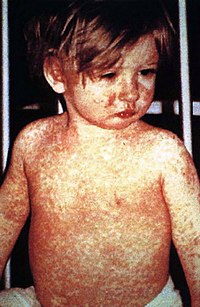
Photo from wikipedia
Between May 2017 and November 2018, Greece has experienced a severe measles outbreak with a total of 3258 cases reported, after reaching its goal of eliminating measles since 2014–2015. In… Click to show full abstract
Between May 2017 and November 2018, Greece has experienced a severe measles outbreak with a total of 3258 cases reported, after reaching its goal of eliminating measles since 2014–2015. In this study, we aimed to investigate the origin and the dispersal patterns of the measles strains that circulated in Greece during this outbreak and to identify possible transmission patterns of measles virus (MeV) in the country. Of the 832 measles suspect cases referred to the National Measles and Rubella Reference Laboratory for MeV RNA detection, 131 randomly selected positive samples, representative of the temporal and spatial distribution of the laboratory-confirmed measles cases in Greece, were processed for genotypic identification by an RT-PCR amplification of a 598 bp fragment containing the 450 bp hypervariable region of the measles virus N gene. Phylogenetic analysis was carried out by the approximate maximum likelihood method (ML) under the generalized time-reversible (GTR + cat) model. All samples analyzed were found to belong to genotype B3. Comparative analysis with other European and reference measles strains revealed three separate major clusters and other multiple viruses circulating simultaneously in Greece. They were all isolated from three main community groups, Greek-Roma children, non-minority Greek nationals and immigrants/refugees, a finding that is in accordance with what was also observed in the last two measles outbreaks in 2005–2006 and 2010–2011. Notably, for one of the three clusters, no similarity was detected with previously reported prototype strains. Our results indicate the need for a more intensive vaccination program against measles amongst minority populations and in refugee hot-spots as well as the importance of molecular surveillance as a tool for monitoring measles outbreaks.
Journal Title: Viruses
Year Published: 2020
Link to full text (if available)
Share on Social Media: Sign Up to like & get
recommendations!